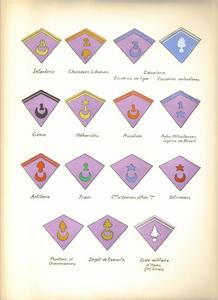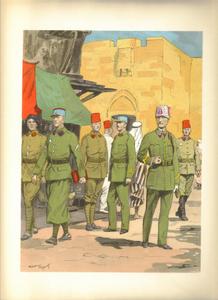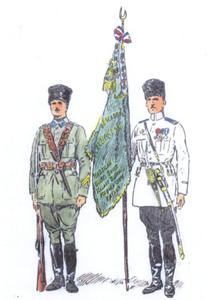|
Welcome to Kurdistan sky scrapers forum. Hope you enjoy your visit. You're currently viewing our forum as a guest. This means you are limited to certain areas of the board and there are some features you can't use. If you join our community, you'll be able to access member-only sections, and use many member-only features such as customizing your profile, sending personal messages, and voting in polls. Registration is simple, fast, and completely free. Join our community! If you're already a member please log in to your account to access all of our features: |
| French Kurdish Squadron of Levant 1920-1946 | |
|---|---|
| Topic Started: 18th September 2014 - 05:19 AM (10,375 Views) | |
| Frenchy | 18th September 2014 - 05:19 AM Post #1 |


|
French Kurdish Squadron of Levant 1920-1946 1920-1923 French-Turkish war In 1920, the French were given a mandate over Syria and Lebanon by the League of Nations: it was known as the French Mandate of Syria and Lebanon. The French army then occupied the former Ottoman empire territory of Syria and Lebanon and raised a force called the "Légion Syrienne" (Syrian Legion). This comprised both cavalry and infantry units and was drawn mainly from minority groups such as Kurds. This legion was raised to defend the territory from the Arabs who were against the French rule of Syria (short French-Syrian war of 1920). The same year, the treaty of Sèvres was signed. This treaty proposed the creation of a Kurdish state: the idea was supported by France since the Sykes–Picot Agreement in 1916 (secret agreement between France and the UK defining spheres of influence in Middle East after the war). Even more, most of the Kurdish inhabited areas in the mandate of Syria or in the Ottoman empire were under French influence: being in control of these areas, it was then easy for France to achieve the creation of a Kurdish state. And according to the treaty of Sèvres, the Kurds from the British mandate of Iraq were supposed to join the new Kurdish state after a plebiscite.  But the Ottoman empire collapsed and the new Turkish state refused to respect the treaty of Sèvres. The French Syrian legion, helped by French reinforcements and auxiliaries (Armenian and Kurdish soldiers), fought against Turkey. But France had just finished World War One and lost millions of soldiers: they couldn't hold the Syrian front and had to agree to sign a new treaty with Turkey in 1923 at Lausanne. In this new treaty, Kurdistan was cancelled against the French willingness (see the French-turkish treaty of 1922 in which nation states were still supposed to be created). Around 7,000 French soldiers died fighting for Kurdistan and Armenia in 1920-1923, alongside thousands of Armenian and Kurdish auxiliaries. The French mandate of Syria and Lebanon and the Druze revolution After 1923, the French Mandate Administration in Syria followed a principle of divide and rule in organising the country (centralised power in Damas and Beyrouth) and the "Troupes Spéciales" (Special troops) of the Army of the Levant. The Sunni Muslim Arabs of Syria, who made up about 65% of the population, were excluded from military service with the "Troupes Spéciales". The French Mandate Administration was using mainly Druze, Christian, Kurde, Circassian and ‘Alawi minorities. The Christians believed France would help them build a Christian nation in Lebanon, but instead the French administration chose the principle of divide and rule when creating the frontiers of Lebanon. From 1926 to 1941, the Kurds, alongside the Druze and Circassian (Tcherkess) were forming squadrons of mounted infantry, forming the auxiliary troops of the Army of the Levant. These Kurdish "Troupes Supplémentaires" (Auxiliary troops) provided a form of "Gendarmerie" (military police) for internal security purposes against the other minorities and were primarily deployed in the areas of their recruitment (Kurdish inhabited areas). The Kurdish auxiliary troops were led by Kurdish officers and non-commissioned officers with a small cadre of French officers. During the harsh Syrian/Druze revolution of 1925-1927, the French army of the Levant had to struggle to win against the rebels. The Circassian (Tcherkess) and Kurdish squadrons were amongst the loyal troops and helped greatly to defeat the Arabs and Druze rebels. Uniforms of the Kurdish auxiliary troops Uniforms of the Kurdish auxiliary troops varied according to arm of service, but showed a mixture of French and Kurdish influences. Kurdish personnel wore their indigenous headdress. A common feature across the "Troupes Spéciales" was the use of "violette" (purple-red) as a facing colour on tunic collar patches, belts and kepis. Kurdish squadron insignia (see above) included the specificity of the unit (mounted infantry) and the crescent of the Levant.    Uniforms of the "Troupes Spéciales" of the Army of the Levant in 1935. The first plate shows the collar tabs, the Kurdish collar tabs should be the one in the top right corner (Cavalerie). The second and third plates shows the soldiers of the Army of the Levant in 1935.  Circassian squadron uniforms, similar to the Kurdish squadron, aside Tcherkess influence. Light squadrons of the "Troupes Spéciales" of the Army of the Levant (probably Circassian). Syria-Lebanon campaign 1941 and the end of the French mandate In 1941, the French Army of the Levant was defeated by the British and Free French armies (France was occupied by Germany since 1940 et was collaborating with them. But some French joined the British and formed the Free French Army against Germany). Then, Free France recognised the independence of Lebanon and Syria, but a period of military occupation followed until the end of World War Two. In 1943, Lebanon became an independent state and in 1944, Syria also became an independent state. The "Troupes Spéciales" had remained in existence during the military occupation and were transferred to the new Syrian and Lebanese Army.
Edited by Frenchy, 4th November 2014 - 10:11 PM.
|
 
|
 
|
| Karker | 18th September 2014 - 06:03 AM Post #2 |


|
That's cool |
 
|
 
|
| Azadi | 17th October 2014 - 09:20 PM Post #3 |

Scarlet Speedster

|
Hmm, if this had actually gone through, we would have lost a lot of Kurdish land. |
 
|
 
|
| Xoybun | 17th October 2014 - 09:29 PM Post #4 |

PERMANENTLY BANNED

|
They wanted to give Armenia so much land, and this probably because they are Christians... |
 
|
 
|
| Odar | 22nd October 2014 - 05:08 AM Post #5 |


|
Or maybe guilt after a genocide in which they were a bit responsible of by playing the Armenian question as a mean of pression against the Ottoman state, but doing nothing to actually resolve it. Btw it was ink in paper, and they never really tried to make it work, and as far as I know the Legion was operating in Cilicia, not in the East but I may be wrong. The Europeans actually mostly despised the Eastern Christians, to those submitted muslim-faced people they never really felt kinship, and especially for the British they prefered Muslim people, less educated at the time and thus easier to manipulate for their interests they thought (that's well documented as a state of mind). The French were still a bit in line with their "protector of the Eastern Christians" title inherited from the crusades but that was not a big deal against conceived national interests (especially economical). But there was ample documentation over what happened to the Armenians in the western press at the time so it was a bit of a "compensation" like Israel for the Jews after WW2. Anyway the thing is the Armenian delegation in Sèvres was much more efficient than the Kurdish one, which had hardly any unified basis to begin with and had hard time showing a consensus on a map. The Ottoman Empire had very well succeeded in breaking and using the Kurds since the first 1800s Kurdish uprisings, and Kemal had no difficulty to begin its "liberation" campaign with a Kurdish army only to brutally crush Kurds some years after. The Armenians on the other hand had maps from antiquity to support their claim, yeah well, but given the authority of that Treaty anyway. More something for the show. In reality the European powers were supporting Kemal as a bargaining chip with the Sultan of Istanbul (and well... that was all he had poor Sultan) and they later became overtaken and had to retreat in hast. I let you guess what happened of what was left of the minorities they were pretending to rely upon... Not the most glorious times of the French army I fear.
Edited by Odar, 22nd October 2014 - 05:09 AM.
|
 
|
 
|
| MedianKurd | 30th October 2014 - 01:44 AM Post #6 |


|
Well EK would have joined kurdistan anyway because during these time we had qazi mohammed and qasimlo who would have made ek independent and join kurdistan,+ they would have more support |
 
|
 
|
| RawandKurdistani | 31st October 2014 - 03:45 PM Post #7 |

Surchi/Xoshnawi

|
But EK would have been less than half of it's actual size.
Edited by RawandKurdistani, 31st October 2014 - 03:47 PM.
|
 
|
 
|
| MedianKurd | 1st November 2014 - 08:08 PM Post #8 |


|
well i see ilami's protesting for kobani too so if they had support from an actuall kurdish state back then it could be possible |
 
|
 
|
| RawandKurdistani | 1st November 2014 - 08:42 PM Post #9 |

Surchi/Xoshnawi

|
It would probably be harder to make territorial claims actually, considering that we would already have an independent Kurdistan in that case, meaning few would consider added claims to be liberation. |
 
|
 
|
| 0 users reading this topic | |
| « Previous Topic · Kurdish Military · Next Topic » |






 6:45 PM Nov 19
6:45 PM Nov 19